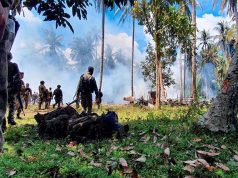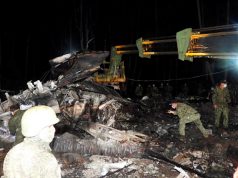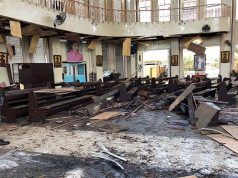
MANILA — Philippines security forces investigating a deadly twin bombing at a church on a predominantly Muslim southern island are zeroing in on what they say is an affiliate of the militant Abu Sayyaf Group.
Twenty people were killed and more than 100 wounded in Sunday’s attack on Jolo island, shocking a region that only days earlier delivered a resounding “yes” in a plebiscite on greater autonomy for the Muslim-dominated south.
Who are the main suspects?
Jolo is a stronghold of the militant Abu Sayyaf Group (ASG), making it a prime candidate.
More specifically, authorities believe the bomb attack was orchestrated by a faction called “Ajang-Ajang”, which is notorious for kidnapping and extortion in Sulu province. It is the first time the military has mentioned this group.
What was the motive?
Police believe Ajang-Ajang carried out the attack in revenge for the deaths of relatives killed during military operations against Abu Sayyaf.
According to Rommel Banlaoi, head of the Philippine Institute for Political Violence and Terrorism Research, the group’s members consider themselves “soldiers of martyrs” and appear highly capable, having pulled off such a devastating attack when security was tight for the referendum.
“This group outsmarted law enforcement authorities,” Banlaoi said. “Sulu has been receiving threats coming from this group. This will inspire other groups to do some more.”
What is known about Abu Sayyaf?
Abu Sayyaf, which means “Bearer of the Sword”, was founded in the 1990s with its roots in a separatist cause that it long since abandoned. It lacks a central command and operates in cells across the Sulu archipelago.
The group has grabbed headlines for bombings and pledges of allegiance to Islamic State and links to al Qaeda, but its main activities have been piracy and kidnapping.
It is notorious for brutality, posting videos of captives, foreign and local, begging for their lives. Those for whom ransoms are not paid are often decapitated.
The ASG is fragmented, comprised of various clans or family-based factions operating under different commanders in different areas.
But ASG’s radical streak cannot be ignored. Isnilon Hapilon, a faction commander from Basilan, was anointed as Islamic State’s “emir” in Southeast Asia. He was credited with bringing together foreign fighters and members of various groups from Mindanao island to occupy Marawi City in 2017, under an alliance known as Dawla Islamiya, which sought to carve out an Islamic State territory.
The fighters held Marawi through five months of air strikes and ground operations but collapsed within a week of the military killing Hapilon. His death does not appear to have weakened Abu Sayyaf.
Church attack linked to Islamic State?
Islamic State, via its Amaq news agency, claimed responsibility for the church attack, although the details it gave were not consistent with those from authorities. The group said the attack was twin suicide bombings, rather than remotely detonated devices, and its death toll appears to be exaggerated.
Security analyst Banlaoi considers Ajang-Ajang to be pro-Islamic State, noting that it is led by the father-in-law of Malaysian operative Amin Baco, who was involved in planning the Marawi occupation.
Response to referendum?
That has been widely assumed and should not be ruled out. The region as a whole voted overwhelmingly in support of autonomy, although the plan was narrowly rejected in Sulu, where some influential politicians had opposed it, including a Supreme Court challenge.
The separatist Moro Islamic Liberation Front (MILF), which opposes the Abu Sayyaf, is likely to dominate the transition authority and the elected government of the new Bangsamoro administration. That could threaten some political interests and patronage arrangements in Sulu and be seen as a challenge to Abu Sayyaf’s power. However, the timing of the bombings — six days after the vote — raises some doubts.
Is an Abu Sayyaf defeat likely?
Not soon. Offensives from 2001 by the Philippine military with help of U.S. special forces under “Operation Enduring Freedom” made some progress in killing senior commanders but that led to splintering and increased kidnapping to raise funds. In recent years, ASG has started to engage more in piracy.
President Rodrigo Duterte has offered talks but has also promised to wipe them out. He has created a Jolo-based infantry division, to be comprised of 4,500 troops by 2022, to go after the ASG and last month oversaw the deployment of its first 840 personnel.
In a Jan. 9 report, the Jakarta-based Institute for Policy Analysis of Conflict argued that non-military measures were key to defeating ASG. It advocated capturing and interviewing militants rather than killing them, which could be “critical to understanding ASG networks and identifying possible policy interventions”.
— Additional reporting by Karen Lema; Editing by Robert Birsel









